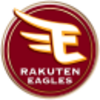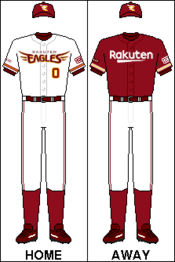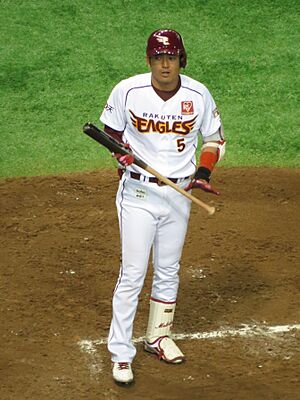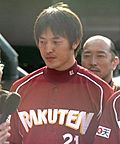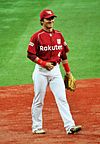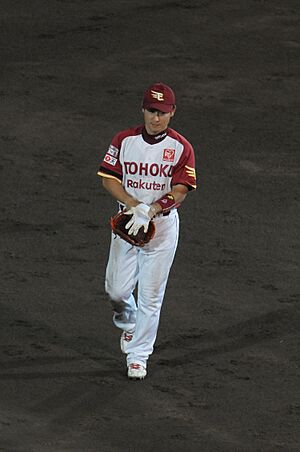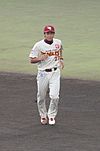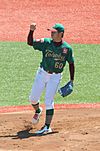Tohoku Rakuten Golden Eagles facts for kids
Quick facts for kids Tohoku Rakuten Golden Eagles |
|||||
|---|---|---|---|---|---|
| 東北楽天ゴールデンイーグルス | |||||
|
|||||
| Information | |||||
| League | Nippon Professional Baseball
|
||||
| Location | Miyagino-ku, Sendai, Miyagi, Japan | ||||
| Ballpark | Rakuten Mobile Park Miyagi | ||||
| Year founded | November 2, 2004 | ||||
| Nickname(s) | Inuwashi (イヌワシ, golden eagles) | ||||
| PL pennants | 1 (2013) | ||||
| Japan Series championships | 1 (2013) | ||||
| Colors | Crimson, White, Yellow |
||||
| Mascot | Clutch, Clutchena, and Switch | ||||
| Playoff berths | 5 (2009, 2013, 2017, 2019, 2021) | ||||
| Retired numbers | |||||
| Ownership | Hiroshi Mikitani | ||||
| Management | Rakuten Baseball, Inc. | ||||
| Manager | Hajime Miki | ||||
| President | Masayuki Morii | ||||
| Uniforms | |||||
|
|
|||||
The Tohoku Rakuten Golden Eagles (東北楽天ゴールデンイーグルス), often called the Rakuten Eagles (楽天イーグルス), are a professional baseball team from Sendai, Japan. They play in the Pacific League, which is part of Nippon Professional Baseball (NPB). The team was started in November 2004 and is owned by the online shopping company Rakuten.
| Top - 0-9 A B C D E F G H I J K L M N O P Q R S T U V W X Y Z |
Team History: How the Eagles Began
Starting the Team in 2004
In 2004, two baseball teams, the Osaka Kintetsu Buffaloes and the Orix BlueWave, decided to join together. Both teams were in the Pacific League. This merger would have left the Pacific League with fewer teams than the other league, the Central League.
Many players were worried about losing their jobs. So, they went on a two-day strike in September 2004. To solve this problem, the league decided to allow a new team to join. Two internet companies, Livedoor and Rakuten, wanted to create a team in Sendai. Rakuten was chosen to form the new team.
The new team was named the "Tohoku Rakuten Golden Eagles." The name comes from the golden eagle, a large bird found in Japan's Tōhoku region. This team is special because it's the only NPB team named after an entire region, not just a city or prefecture.
Building the First Roster
Instead of picking players from all NPB teams, the Eagles had to choose from players left over from the two merged teams. This was called a special dispersal draft. The Orix team got to protect 25 of their best players first. Then, Rakuten could pick 20 unprotected players. After that, Orix and Rakuten took turns picking 20 more players.
This way of picking players made it hard for the Eagles at first. But they did get some good players. For example, they got outfielder Koichi Isobe and star pitcher Hisashi Iwakuma.
First Seasons: 2005-2009
The Eagles had a tough start in their first season (2005). They lost many games and finished last. But there was one good moment: their first home game. Even though the stadium was still being fixed up, the game went smoothly, and many fans came. The team also brought a lot of money to the Tōhoku region.
For their second season, Rakuten hired a famous manager, Katsuya Nomura. The team got a little better. In 2006, third baseman José Fernández won the team's first Best Nine Award. At the end of 2006, Rakuten drafted pitcher Masahiro Tanaka, who would become a huge star.
Getting Better and Reaching the Playoffs
The team really started to improve in 2007. Takeshi Yamasaki led the league in home runs for a while and was named the Pacific League MVP for May. He was also chosen by fans to play in the All-Star Series, along with seven other Eagles players, including rookie pitcher Tanaka. The Eagles finished fourth that year, not last! Yamasaki led the league in home runs and RBIs, and Tanaka won the Rookie of the Year Award.
In 2008, the team finished fifth. However, pitcher Iwakuma had an amazing season. He had the best earned run average (ERA) and most wins in the league. He won the team's first Pacific League MVP and the Eiji Sawamura Award, which is given to the best pitcher.
In 2009, the Eagles finished second in the Pacific League. This meant they made it to the Climax Series for the first time! They won the first round but lost to the Hokkaido Nippon-Ham Fighters in the second round.
From Disaster to Champions: 2010-2013
After 2009, the Eagles changed managers a few times. In 2011, Senichi Hoshino became the new manager. Players like Kazuo Matsui and Akinori Iwamura also joined the team after playing in Major League Baseball (MLB).
The 2011 Earthquake and Tsunami
On March 11, 2011, a huge earthquake and tsunami hit the Tōhoku region, including Sendai. The baseball season was delayed. The Eagles trained in another part of Japan while their home city recovered. All 12 NPB teams played charity games to help raise money for the earthquake relief.
Baseball returned to Sendai on April 12, 2011, when the Eagles played their first home game. The final game of the 2011 All-Star Series was also moved to Miyagi Stadium to show support for the region. The Eagles finished fifth that season. Pitcher Masahiro Tanaka won the Pacific League MVP of the month three times, which was a first for the league.
Winning the Japan Series in 2013
In 2012, Hisashi Iwakuma left to play in MLB. The Eagles almost made the playoffs but finished fourth. Before the 2013 season, they signed former MLB players Casey McGehee and Andruw Jones.
The 2013 season was incredible! Masahiro Tanaka won MVP of the month awards for five months in a row. The team took first place in the Pacific League in July and never gave it up, winning their first league championship. Tanaka finished the season with an amazing 24 wins and no losses!
As league champions, the Eagles went straight to the final round of the Climax Series. They beat the Chiba Lotte Marines to reach their first ever Japan Series. In a thrilling seven-game series, Rakuten defeated the Yomiuri Giants at home to win their first and only Japan Series championship!
Pitcher Manabu Mima was named the Japan Series MVP. Tanaka won the Pacific League MVP and Eiji Sawamura Awards. Norimoto was named the Pacific League Rookie of the Year. Manager Senichi Hoshino also received a special award. After this big win, Miyagi Stadium was made even bigger to hold more fans.
After the Championship: 2014-Present
Changes and Challenges
After the 2013 championship, Masahiro Tanaka left to play for the New York Yankees in MLB. Casey McGehee also left. The team struggled without them, finishing last in 2014. Manager Senichi Hoshino resigned.
The team then promoted Hiromoto Okubo to manager. There were some challenges with the team's owner, Hiroshi Mikitani, getting involved in decisions. The team finished last again in 2015, and Okubo resigned. To fix things, Senichi Hoshino, who was now a vice chairman, was given full control over baseball decisions, like a general manager in MLB.
New Managers and Tanaka's Return
In 2016, Miyagi Stadium was renovated again, now holding over 30,000 people. The team hired a new manager, Masataka Nashida. They also signed Toshiaki Imae, a two-time Japan Series MVP. The Eagles finished fifth that year.
In 2017, the Eagles played much better, finishing third in the Pacific League. They made it to the Climax Series again! They won the first round against the Saitama Seibu Lions but lost to the Fukuoka SoftBank Hawks in the final round.
In January 2018, Senichi Hoshino passed away. Rakuten honored him by retiring his uniform number 77 before the season started. The team struggled in 2018, finishing last. Nashida resigned, and Yosuke Hiraishi became the interim manager. Rakuten then created a formal general manager (GM) position and hired former pitcher Kazuhisa Ishii for the role.
Hiraishi became the full-time manager in 2019 and led the Eagles to third place and a playoff spot. But they lost to the Hawks in the first round. After that, Hajime Miki became the new manager. In the shorter 2020 season, the Eagles missed the playoffs. Ishii then became the manager himself for the 2021 season.
In 2021, Masahiro Tanaka returned to play for Rakuten after seven years with the Yankees! The Eagles finished third in 2021 and made it to the Climax Series. However, they did not advance to the final round.
Team Roster
|
Tohoku Rakuten Golden Eagles roster
|
|||||||
|---|---|---|---|---|---|---|---|
| First squad | Second squad | ||||||
|
Pitchers
Catchers
|
Infielders
Outfielders
Manager Coaches
|
Pitchers
Catchers
|
Infielders
Outfielders
Manager
Coaches
|
||||
| Development Players | |||||||
|
|||||||
| Updated October 02, 2022 | → All NPB rosters | ||||||
Players Who Played in MLB
- Active:
* Yuki Matsui (2024–)
- Former:
* Masahiro Tanaka (2014–2020)
- Retired:
* Kazuo Fukumori (2008) * Hisashi Iwakuma (2012–2017)
Team Achievements and Special Numbers
Major Wins
- Japan Series Championship (1): 2013
Retired Uniform Numbers
- 10 – This number was retired in 2004, even before the team's first season. It represents the Eagles fans, showing that they are the "10th member" of the team, after the nine players on the field. No player, coach, or manager has ever worn this number. The team's mascot, Clutch, wears number 10 to represent the fans.
- 77 – This number was retired on March 26, 2018, after the death of manager Senichi Hoshino. He managed the Eagles from 2011 to 2014, leading them to their only Japan Series win in 2013. He stayed with the team as a vice-chairman until he passed away. This is the only manager's uniform number to be retired in NPB.
Team Records (Since 2005)
| Tohoku Rakuten Golden Eagles | |||||||||||
| Year | Manager | Games | Wins | Losses | Ties | Pct. | GB | BA | ERA | Finish | Postseason |
|---|---|---|---|---|---|---|---|---|---|---|---|
| 2005 | Yasushi Tao | 136 | 38 | 97 | 1 | .281 | 51.5 | .255 | 5.67 | 6th, Pacific | Did not qualify |
| 2006 | Katsuya Nomura | 136 | 47 | 85 | 4 | .356 | 33.0 | .258 | 4.30 | 6th, Pacific | Did not qualify |
| 2007 | Katsuya Nomura | 144 | 67 | 75 | 2 | .472 | 13.5 | .262 | 4.31 | 4th, Pacific | Did not qualify |
| 2008 | Katsuya Nomura | 144 | 65 | 76 | 3 | .461 | 11.5 | .272 | 3.89 | 5th, Pacific | Did not qualify |
| 2009 | Katsuya Nomura | 144 | 77 | 66 | 1 | .538 | 5.5 | .267 | 4.01 | 2nd, Pacific | Lost in second stage, 1–4 (Fighters) |
| 2010 | Marty Brown | 144 | 62 | 79 | 3 | .440 | 15.0 | .265 | 3.98 | 6th, Pacific | Did not qualify |
| 2011 | Senichi Hoshino | 144 | 66 | 71 | 7 | .482 | 22.5 | .245 | 2.85 | 5th, Pacific | Did not qualify |
| 2012 | Senichi Hoshino | 144 | 67 | 67 | 10 | .500 | 7.5 | .252 | 2.99 | 4th, Pacific | Did not qualify |
| 2013 | Senichi Hoshino | 144 | 82 | 59 | 3 | .582 | - | .267 | 3.51 | 1st, Pacific | Nippon Series champions, 4–3 (Giants) |
| 2014 | Senichi Hoshino | 144 | 64 | 80 | 0 | .444 | 17.0 | .255 | 3.97 | 6th, Pacific | Did not qualify |
| 2015 | Hiromoto Okubo | 143 | 57 | 83 | 3 | .407 | 33.5 | .241 | 3.82 | 6th, Pacific | Did not qualify |
| 2016 | Masataka Nashida | 143 | 62 | 78 | 3 | .443 | 25.0 | .257 | 4.11 | 5th, Pacific | Did not qualify |
| 2017 | Masataka Nashida | 143 | 77 | 63 | 3 | .550 | 29.5 | .254 | 3.33 | 3rd, Pacific | Lost in final stage, 2–4 (Hawks) |
| 2018 | Masataka Nashida Yosuke Hiraishi |
143 | 58 | 82 | 3 | .414 | 15.0 | .241 | 3.78 | 6th, Pacific | Did not qualify |
| 2019 | Yosuke Hiraishi | 143 | 71 | 68 | 4 | .511 | 15.0 | .251 | 3.74 | 3rd, Pacific | Lost in first stage, 1–2 (Hawks) |
| 2020 | Hajime Miki | 120 | 55 | 57 | 3 | .491 | 16.5 | .258 | 4.19 | 4th, Pacific | Did not qualify |
| 2021 | Kazuhisa Ishii | 143 | 66 | 62 | 15 | .516 | 5.5 | .243 | 3.40 | 4th, Pacific | Lost in first stage, 1–1–2 (Marines) |
| 2022 | Kazuhisa Ishii | 143 | 69 | 71 | 3 | .491 | 6.5 | .243 | 3.47 | 4th, Pacific | Did not qualify |
| 2023 | Kazuhisa Ishii | 143 | 70 | 71 | 2 | .496 | 17.0 | .244 | 3.52 | 4th, Pacific | Did not qualify |
| Total | -- | 2545 | 1150 | 1319 | 76 | .460 | – | – | – | – | - |
Team Look: Logos and Uniforms
The Eagles' main color is crimson red, which is also the color of their owner, Rakuten. Yellow is used as an accent color to represent a golden eagle. The team's logo has the word "Eagles" with wings, and "Rakuten" is above it. The winged "E" from this logo is also on the team's baseball caps.
The team's caps are crimson red. Their shiny helmets match the cap design and are made using a special Japanese lacquer technique. The company that makes the uniforms has changed over the years. Since 2020, Mizuno Corporation has supplied the uniforms. The uniforms also have logos of different sponsors.
Home and Away Uniforms
The Eagles' home uniforms are all white. The pants are white with crimson stripes down the sides. The white jersey has the team's logo on the front with the player's number. The player's name and number are on the back.
After the 2011 earthquake, a special patch was added to the left sleeve of all home and away uniforms. It says "Let's do this, Tōhoku" (がんばろう東北) as a symbol of support for the region. The home jersey design has changed a few times, with yellow accents becoming gold and stripes added or removed from the collar and sleeves. The current home jersey, from 2020, is similar to recent designs but without collar stripes.
The team's away uniforms are crimson red. They use the same pants as the home uniforms. The red jersey has the name "Rakuten" on the chest. The design of the away jersey has changed more often. The first design had a white "Rakuten" logo with a yellow shadow. Later, the yellow was removed, and the font was updated.
The current away jersey, also from 2020, has gold outlines on the back name and number. It also has a gold stripe on the white stripes around the sleeves.
Special Uniforms for Different Occasions
The Eagles have also worn many special uniforms for different events or seasons.
- A third alternate uniform was used for home games during interleague play from 2006 to 2011. These were mostly white with crimson sides.
- Starting in 2007, players wore special "Fan Club Day" uniforms. These designs were sometimes chosen by fans. In 2012 and 2013, these jerseys were crimson red.
- From 2014, these became "Fans' uniforms" and were worn for games in the Tōhoku region. They often had "Tohoku" on the chest instead of the team logo.
- For the team's 15th season in 2019, the Fans' uniform was grey. In 2020 and 2021, it was black.
The Eagles have also worn other themed uniforms:
- The "Eagle Rainbow" uniform in 2011 celebrated the team's seventh season (a lucky number in Japan). It had seven shades of red, orange, and yellow. These jerseys were auctioned to help earthquake relief.
- The "Eagle Star" uniform in 2012 had crimson pinstripes.
- The "Tohoku Green" theme started in 2013 to highlight forest conservation in Tōhoku. These jerseys were green with "Tohoku" across the chest.
- "Eagle Summer" uniforms in 2016 brought back pinstripes and had "Rakuten" on the chest.
- "Black Eagles" in 2017 and "Tōhoku Pride" in 2018 were black versions of other uniforms.
- The current special uniform theme is "Tohoku Blue," which started in 2019. These jerseys are blue to represent the sky. The 2020 and 2021 versions are white with blue pinstripes.
Team Mascots
The Eagles have a pair of golden eagle mascots named Clutch (male) and Clutchena (female). Their names come from the word "clutch," like an eagle's grip, and also a baseball term for important moments. Clutch wears jersey number 10, which is retired for the fans.
In 2016, a third mascot named Switch, a harpy eagle, was introduced. The team also sometimes features an unofficial, playful mascot called Mr. Carrasco, who is a black crow character that rides a motorcycle.
Farm Team
The Golden Eagles also have a farm team that plays in the Eastern League. This team helps develop new players for the main Eagles team. It was founded in 2005.
See also
 In Spanish: Tohoku Rakuten Golden Eagles para niños
In Spanish: Tohoku Rakuten Golden Eagles para niños
- "The Manpower!!!" (THE マンパワー!!!) – the first official cheer song for the Golden Eagles, by the J-pop group Morning Musume.
- "Koero! Rakuten Eagles" (越えろ!楽天イーグルス) – the fourth official cheer song for the Golden Eagles, by the J-pop group Cute.
- Vegalta Sendai


